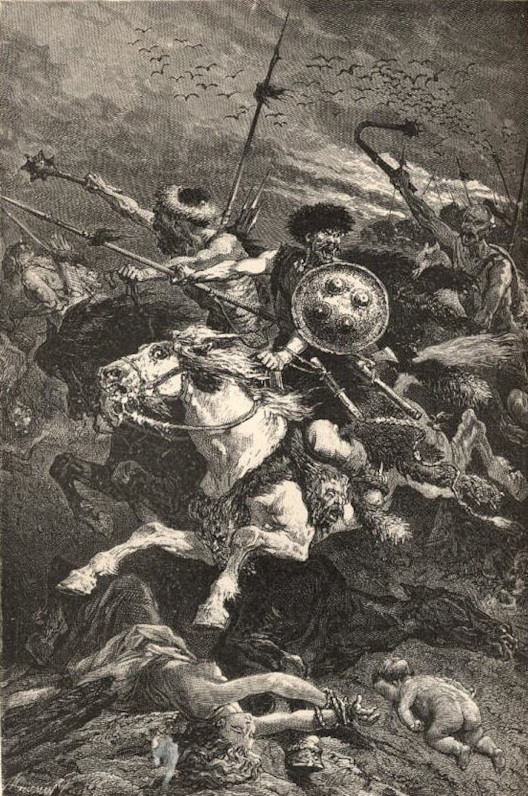
“The Huns at the Battle of Chalons,” published in 1875 in A Popular History of France From The Earliest Times, Volume I by A. De Neuville | Image source
TL;DR;
After the fall of the Roman Empire, Christianity spread rapidly among the Germanic and Slavic tribes who had conquered its territories. Two cultural factors explain this: (1) tribal conversion dynamics and (2) cultural disintegration and renewal. This northward expansion of the gospel marked a transformative era in European history. Missionaries such as Boniface, Cyril and Methodius, and Patrick played pivotal roles.

“The Huns at the Battle of Chalons,” published in 1875 in A Popular History of France From The Earliest Times, Volume I by A. De Neuville | Image source
In the opening of his letter to the Romans, the Apostle Paul refers to the spiritual needs of ethnolinguistic groups outside the Graeco-Roman sphere. "Barbarians" is the way the King James Version translates the Greek label for those peoples living north of the boundaries of the Roman Empire. Other English Bible translators have used words like natives, local people, uncivilized people, non-Greeks, savages, and foreigners to translate that word in Romans 1:14. At any rate, warriors from the north began to invade the crumbling Roman Empire. They eventually destroyed it with the fall of the city of Rome itself coming in 476 A.D.
It is fascinating to see that, among the peoples of central and northern Europe, the religion of the people to the south whom they had conquered became — in a relatively short period of time — the religion of the conquerors themselves. One might think that the opposite would have happened, that the Christianity of the Roman Empire would have given way to the gods of the conquering Germanic and Slavic tribes. Why, during the period from approximately 400 A.D. to 800 A.D., would the northern victor adopt the religion of the vanquished south?
Some keys to understanding the evangelization of the Germanic and Slavic peoples, a.k.a. "the barbarians" (which originally meant all non-Greek speaking peoples), can be found in their culture. At least two cultural factors helped the acceptance of Christianity by those peoples living to the north of the borders of the sphere of Graeco-Roman culture:
The culture of central and northern Europe was tribal in nature. When a tribal chief or key elder adopted Christianity, mass conversions within that tribe often followed. Historian Kenneth Scott Latourette noted that, traditionally, religion among the barbarians "had been a community affair."1 So it was that when a Germanic tribe did become Christian, it often did so en masse. While this may make -- from our Western point of view -- for a superficial conversion experience, it does help us understand the dynamics of the conversion of the "non-Greek speakers" (the way "barbarian" was originally understood) in the fifth, sixth, seventh, and eighth centuries.
Latourette asserts that as the barbarians militarily overran most of the Roman Empire, the barbarians' own way of life or cultures, "including their religions,"2 began disintegrating upon impact with what was left of Graeco-Roman civilization. So, Christianity did not find itself in head-to-head competition with established religious beliefs tightly bound into a stable culture. Rather, Christianity found itself spilling into a developing vacuum.
The cultural disintegration came about, some anthropologists would say, because of the impact the "higher" culture had on the "lower" one. This is not a pejorative judgment. It is a recognition that the barbarians had not built cities. They didn't have the kind of art — painting or sculpture or ceramic work — that was characteristic of the Greco-Roman world. Reading and writing were almost unknown to the barbarians. As a barbarian culture encountered the Greco-Roman world, which had all of the above things, the barbarian culture tended to disintegrate.
In this situation, Christianity may have made rapid advances because it served as a positive force in spurring cultural advances. Latourette says, "As it won over the barbarian invaders from the north, Christianity became a major stimulus in stirring them to produce an advanced civilization."3 So, Christianity may have won relatively quick acceptance because it served as a catalyst for cultural rebuilding. Rather than being a destructive threat, Christianity had become a friend to the barbarians' culture. It was seen as something to be welcomed rather than fought against.
1 Kenneth Scott Latourette, A History of Christianity (New York: Harper and Row, 1975) p. 404.
2 Ibid., p. 270
3 Ibid.
-- Howard Culbertson, hculbert@snu.edu
From 400 to 800 A.D., the evangelization of the Germanic and Slavic peoples marks a key chapter in the spread of Christianity in Europe.
Missionaries such as Boniface played key roles in converting Germanic tribes, establishing churches, and forming religious practices. Their efforts were met with challenges such as cultural barriers and resistance fueled by pagan beliefs. Despite the obstacles, the Christian faith gradually gained ground among the Germanic peoples, influencing their societal norms and political structures.
Similarly, in the Slavic regions, the Byzantine Empire played an important role in Christianizing Slavic tribes, particularly through missionaries like Cyril and Methodius. They created the Glagolitic and Cyrillic alphabets to translate the Bible into Slavic languages. This period (400-800 AD) witnessed a gradual integration of Christianity into the fabric of Germanic and Slavic societies.
Celtic Christianity, as exemplified by figures like Patrick, played a noteworthy role in evangelizing various tribes and regions of Europe. While perhaps not as widely known as other forms of Christianity in terms of global impact, Celtic Christianity had a unique approach and cultural context that allowed it to reach and influence certain communities.
One of the distinctive features of Celtic Christianity was its adaptability to local customs and traditions. That made possible its acceptance among different tribal groups. Additionally, Celtic monks and missionaries were known for their zeal in spreading the Christian message, establishing monasteries, and promoting learning and scholarship.
| After the evangelization of the barbarian tribes, the gospel began moving into Scandinavia. [ more ] |